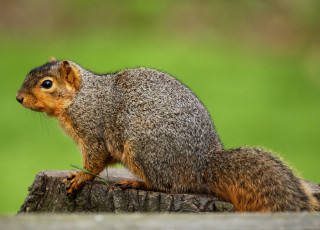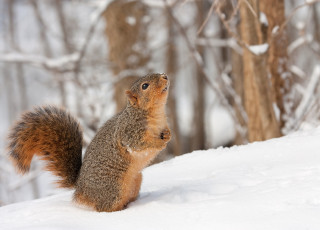Utah Fox Squirrels
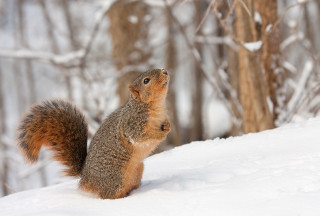
Squirrel Fest returns December 6-14, 2025!
Calling all citizen scientists — we need your help collecting data during Squirrel Fest 2025! Spend 5 minutes outside and let us know whether or not you see squirrels in your area. The first 250 surveys will be eligible for a new limited edition squirrel sticker!
NHMU is studying Fox Squirrels, and we need your help!

The Fox Squirrel (Sciurus niger), a species native to the eastern US, has recently become established in Utah. First reported in 2011 along the Jordan River in Salt Lake City, this tree squirrel has been spreading throughout northern Utah. The arrival of Fox Squirrels offers an opportunity to study, first-hand, the ecology of an introduced species.
We need the help of the community - that's you! - to learn more about Fox Squirrels in Utah. Use the links below to access our squirrel survey to share information about the presence, or absence, of Fox Squirrels in your area. This information will help NHMU scientists explore the changing distribution of Fox Squirrels and understand how they are interacting with their environment.
You can access the survey in two ways:

Web Browser
Click below to access the survey in a web browser on your computer or mobile device. No sign-in required.

Mobile App
Click below and select "Open in field app" or "Download" to get the free Survey123 mobile app, and search for "NHMU Fox Squirrel Survey." No sign-in required.
How to Observe Squirrels
Our survey is designed to capture data from one location (e.g., your yard) in one observation session (period of time you are looking for squirrels). You may submit a new survey form each time you change locations, or are going out for a new observation session. All information collected is for research purposes only – privacy respected!
When observing squirrels for the survey, we recommend:
- Observe anywhere from 5-15 minutes
- You can look for squirrels wherever you are interested – at home, on a walk, on a hike, etc.
- If you are looking for squirrels in a specific area, and do not see one after 15 minutes, select “No” for the question "Did you see or hear at least one fox squirrel." Not seeing a squirrel is also useful data!
Tips For Identifying Fox Squirrels
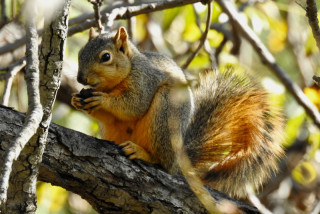
1. Adults are large compared to Utah's native tree squirrels, ranging from 18 to 28 inches in total length (including the tail).
2. Have grizzled gray-and-orange backs and undersides that range from pale yellow to bright orange.
3. Tails are very bushy, bright orange, and very long (very fox-like!) – almost as long as their body.
4. Highly adapted to living in trees, and travelling along power lines and fences. When startled, they will escape by climbing.
Utah's Native Squirrels
Not sure if it's a fox squirrel? Compare it with two native squirrels found in Northern Utah.
American Red Squirrel (Tamiasciurus hudsonicus)
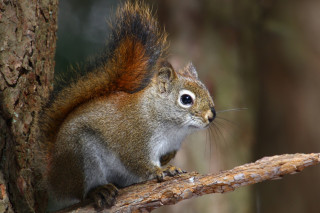
1. Smaller than fox squirrels, about 12-16 inches long including their tails.
2. Have dark, reddish-brown backs and a pale, creamy underside.
3. Tails are not as bushy as a fox squirrel's.
4. Common around conifer trees in parks, but also travel along telephone lines.
Rock Squirrel (Otospermophilus variegatus)
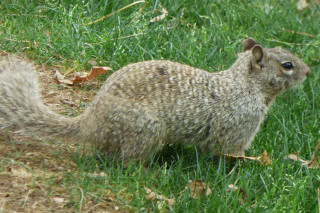
1. About the same size as a fox squirrel.
2. Grizzled gray backs with yellow and brown highlights. Their underside is pale.
3. Long tail, but it is only slightly bushy.
4. Spend most of their time on the ground and run rather than bound.
5. When startled, they will retreat to a burrow or rock pile rather than climb.
NHMU Fox Squirrel Observation Map
Are there Fox Squirrels in your neighborhood? Data shown on this map has been submitted by citizen scientists using NHMU's Fox Squirrel Survey. You can submit your own observations of fox squirrels by accessing the survey via the links above.
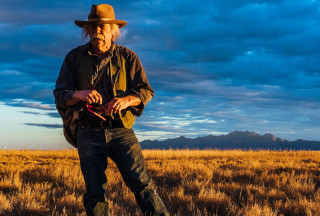
Insights from Biologists
2023 virtual Q&A with NHMU's Dr. Eric Rickart and Katrina Derieg.

Squirrel Zine!
Created by NHMU’s Youth Teaching Youth, this Zine explores squirrels in Utah.
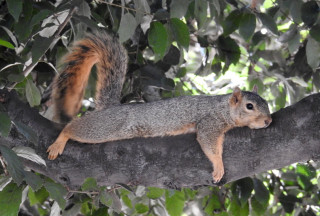
Stay Curious, Utah!
Students and Teachers! Use scientific skills to discover the squirrels in your neighborhood.
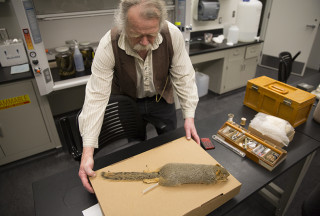

If you have questions about the Utah Fox Squirrels project, please contact NHMU Citizen Science Manager, Ellen Eiriksson.
